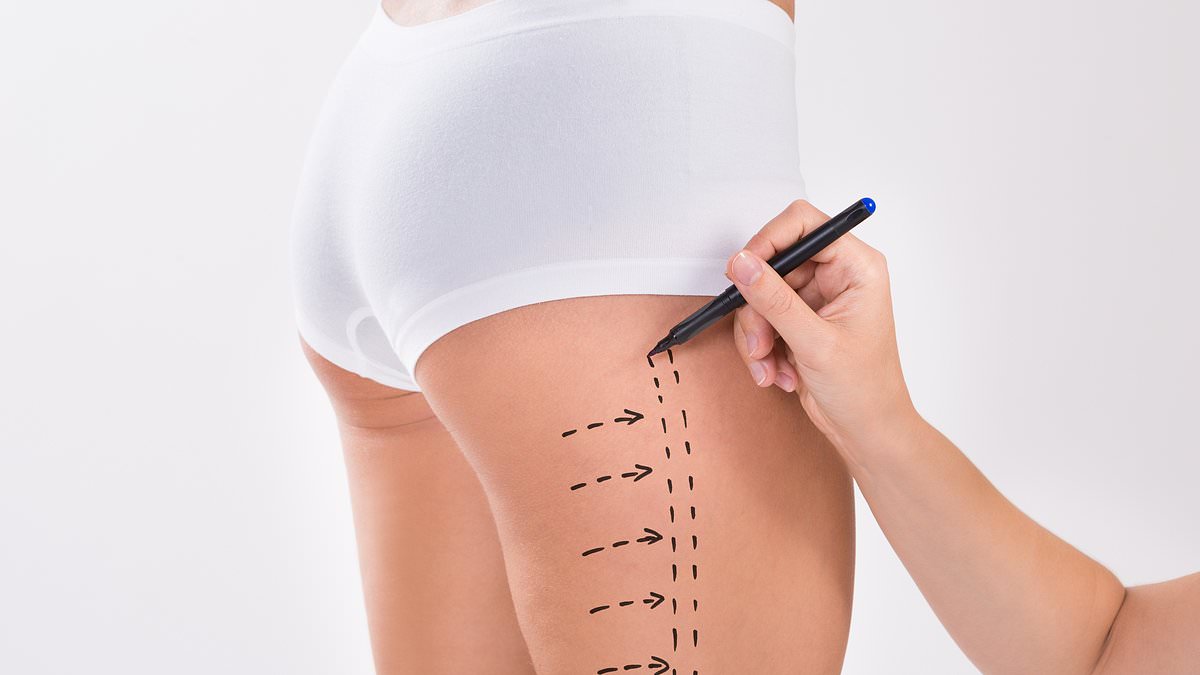The Brazilian butt lift (BBL) silhouette is unmistakable and exceedingly popular, now most associated with the Kardashians and Instagram influencers.
But in the quest for a perfectly plump bottom and shapely thighs, women may overlook its effect on personal cleanliness.
A recent TikTok video inspired a site-wide dialog among men about the ‘BBL smell’ that meets them during intimate moments. His post, where he says the smell was ‘like an assault of my nose,’ has garnered more than 3.5 million views, 152,000 likes and thousands of comments with both men and women confirming the odor and explaining the reasons behind it.
There was a general consensus on where to place the blame. Women, including those who have undergone BBLs, said that a larger backside is simply harder to keep clean after using the restroom.
The male TikToker who goes by the username @donpsoundsoff, set the app aflame with his first-person account about going on a date with a woman with a BBL who, later in the evening, when undressed, emitted a smell that suggested she had not wiped properly or washed that area well enough.

A recent TikTok video inspired a site-wide dialog among men about the ‘BBL smell’ that meets them during intimate moments
It sparked several reaction videos from women on the site.
@PrettyRealist said: ‘When God created us, he gave us arms. All of our arms [are] made specifically for our body. You probably have a hard time wiping your a** properly because your body is a little bit wider than your arms are allowing you to reach in that area.’
Dr Roger Tsai, a board-certified plastic surgeon in Beverly Hills, confirmed the theory in a video disclosing ‘two secrets that Instagram models don’t want you to know about their BBL.’
He said: ‘Wiping down there is gonna be a lot more difficult because there’s more to reach around. So if you’re around somebody with a BBL and they smell…’
Plastic surgeons typically give their patients fair warning about difficulties in the bathroom. Sitting is not allowed for about two months after undergoing a BBL, though sitting on the toilet for a relatively quick bathroom break is ok.
Many physicians recommend bidets to wash the area thoroughly. Otherwise, it may take some ‘painful yoga maneuvers,’ according to one Reddit user who recently had a BBL.
They said: ‘As far as wiping goes, the butt cheeks themselves are super hard and plump immediately following surgery as your body is recovering,’ which makes each buttocks harder to separate.
‘Alternating leg lifting and bending over in various ways- and a sizable wad of toilet paper to really get up in there. I always alternate between toilet paper and baby wipes multiple times to make sure I’m clean before painfully squeezing back into the surgical compression garment that has to be worn 23/7 for 6 months.’
It’s unclear whether trouble in the bathroom is a large enough drawback to convince people not to undergo the surgery, though it doesn’t appear to be.
According to a survey by the International Society of Aesthetic Plastic Surgery, the number of BBLs performed globally increased by nearly 78 percent from 2015 to 2021.
But while it has seen a meteoric rise in popularity, the procedure is considered one of the riskiest out there, with one in every 3,000 patients dying from complications.
And because many women go overseas to get a cut-rate procedure, follow-up with the doctor who performed it is minimal or, in most cases, nonexistent.
In fact, the British Association of Aesthetic and Plastic Surgery advised UK surgeons in 2018 to avoid performing it altogether.
But it didn’t matter – women are so determined to achieve a fuller backside that they are willing to cross borders and put their lives at risk.
Thousands fly yearly to foreign destinations like Brazil, Turkey, Mexico, Colombia, Argentina, and India to get the procedure.
A BBL involves a surgeon harvesting fat from the hips, lower back, abdomen, thighs and other areas via liposuction.
That fat is then reinjected in certain points on the buttocks with a cannula, or long metal tube.
But it’s hard for doctors to see exactly where they are injecting the fat and it could be mistakenly pumped into the gluteal muscle, which can inadvertently introduce fat particles into blood vessels.
These fat particles can travel through the bloodstream and block blood flow to vital organs including the heart, leading to a condition called fat embolism syndrome.
Fat embolism syndrome can cause symptoms such as shortness of breath, chest pain, confusion, and even respiratory failure or cardiac arrest.
This can also cause nerve damage in the area where the fat was injected, leading to paralysis of the lower extremities, chronic pain, and impaired mobility. Additionally, injecting fat in deep tissue raises the risk of infection.
The risk of complications and potentially deadly after-effects have convinced some plastic surgeons to stop offering the service altogether.
Dr Lara Devgan, a New York City-based board-certified plastic surgeon, said: ‘This is my litmus test, my personal golden rule of plastic surgery: If you wouldn’t let your mother or sister or brother have a procedure, you shouldn’t let your patients either.
‘The Brazilian butt lift is an operation that I do not perform any longer, because the mortality data speaks for itself. The risk-benefit calculus simply does not add up.’

